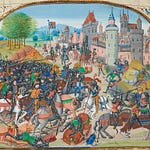Originally published on May 25, 2023 (Episode 317)
Introduction
The village of Oberstdorf lies tucked into the Allgäu Alps, far from major passes and trade routes. For centuries it was an isolated place, surviving on subsistence farming and small-scale mining. But with the arrival of the railroad and the growth of tourism, Oberstdorf was drawn into the wider world. That world soon included Adolf Hitler and the Nazi movement.
At first some residents ignored politics, but over time the ideology of the Third Reich penetrated village life. In their book A Village in the Third Reich: How Ordinary Lives Were Transformed by the Rise of Fascism (Pegasus, 2023), Julia Boyd and Angelika Patel reconstruct how one small community experienced Nazism. Their account shows acts of complicity, violence, and resistance—revealing what it meant to live under fascism not in Berlin or Munich, but in a remote Alpine town.
About the Guests
Julia Boyd is the author of Travelers in the Third Reich: The Rise of Fascism, 1919–1945. Angelika Patel is a local historian of Oberstdorf. Together they co-authored A Village in the Third Reich.
For Further Investigation
Julia Boyd and Angelika Patel, A Village in the Third Reich: How Ordinary Lives Were Transformed by the Rise of Fascism (Pegasus, 2023)
Julia Boyd, Travelers in the Third Reich: The Rise of Fascism, 1919–1945
Related conversation: with Peter Fritzsche on his book Hitler’s First Hundred Days
💬 Listen & Discuss
What does the history of Oberstdorf tell us about how ordinary people respond to authoritarianism? Does the village story complicate the idea of widespread enthusiasm for Nazism—or does it confirm it? Share your reflections in the comments, and pass the episode along to anyone who might be interested.










